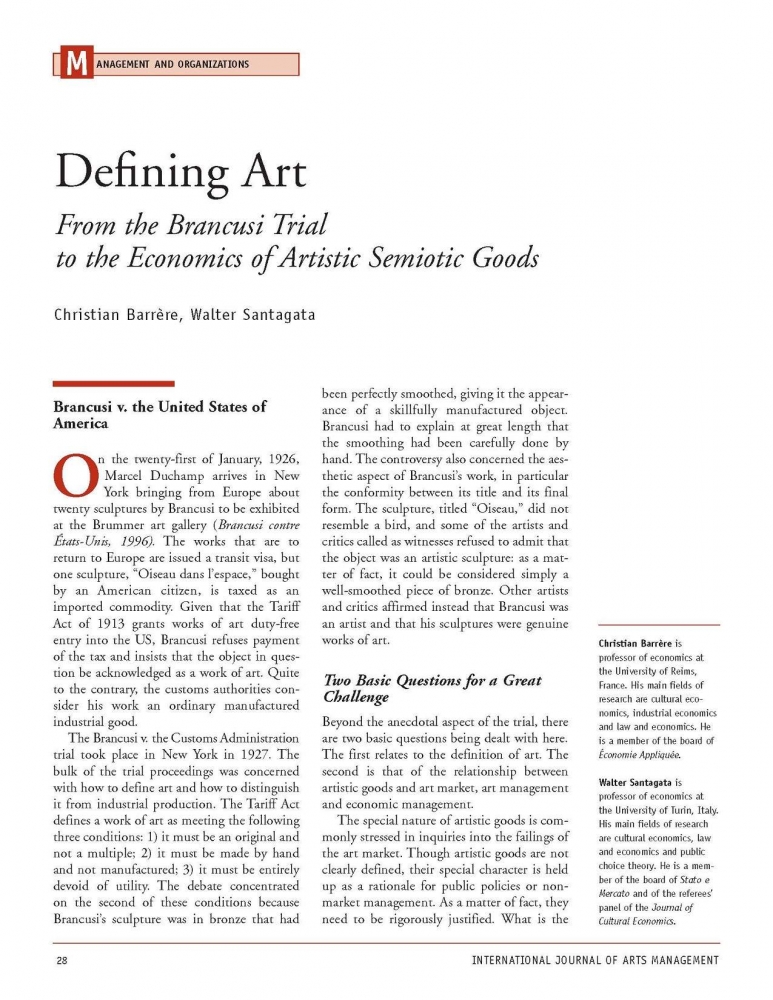Defining Art. From the Brancusi Trial to the Economics of Artistic Semiotic Goods
Produit: Article
21,00 $ CA
C. Barrère, W. Santagata
Christian Barrère is professor of economics at the University of Reims, France. His main fields of research are cultural economics, industrial economics and law and economics. He is a member of the board of Économie Appliquée.
Walter Santagata is professor of economics at the University of Turin, Italy. His main fields of research are cultural economics, law and economics and public choice theory. He is a member of the board of Stato e Mercato and of the referees’ panel of the Journal of Cultural Economics.
ABSTRACT
The special nature of artistic and cultural goods is commonly stressed in inquiries into the failings of the art market. Though artistic goods are not clearly defined, their special character is held up as a rationale for art policies. This paper attempts to ground them theoretically. In the first section, we introduce the concept of artistic goods as a class of semiotic goods – that is, goods that are bearers of an aesthetic sign acknowledged in a specific cultural context. The second section relates the semiotic nature of art to three models of organization and regulation of the artistic field, namely the model based on institutions and hierarchies, the gift model and the market model.
KEYWORDS
Cultural economics
RÉSUMÉ
La spécificité des activités et des biens culturels et l’impossibilité de gérer les arts par les simples forces du marché sont couramment invoquées pour justifier des politiques culturelles élaborées en dépit de l’imprécision qui caractérise la définition d’une activité artistique. Les auteurs s’efforcent justement de donner à cette dernière un fondement théorique. Dans la première partie de l’article, ils introduisent la notion de bien culturel sémiotique, c’est-à-dire porteur d’un signe esthétique reconnu dans un contexte culturel donné. Dans la seconde, ils établissent un lien entre la nature sémiotique de l’art et trois modèles d’organisation et de régulation du domaine artistique, fondés soit sur les institutions et les hiérarchies, soit sur les dons, soit sur le marché.
MOTS CLÉS
Économie de la culture
RESUMEN
Los estudios realizados sobre las debilidades del mercado artístico hacen usualmente hincapié en la naturaleza singular de los bienes artísticos y culturales. Aunque los bienes artísticos no están claramente definidos. Las políticas en el campo de las artes se basan en su carácter particular. Este artículo intenta dar un fundamento teórico a esta argumentación. En la primera parte, introducimos el concepto de bienes artísticos como una categoría de bienes semióticos, es decir, bienes portadores de un signo estético reconocido en un contexto cultural específico. La segunda parte vincula la naturaleza semiótica del arte a tres modelos organizativos y normativos que existen en el ámbito artístico, a saber, el modelo institucional y jerárquico, el modelo orientado al concepto de regalo y el modelo orientado al mercado.
PALABRAS CLAVE
Economía cultural
